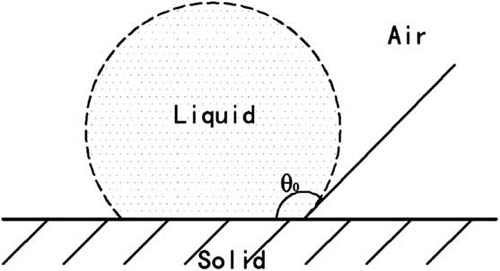Abstract: The underlying theories interpreting wetting phenomena are still mainly focused on the Young’s equation, the Wenzel equation, and the Cassie–Baxter equation, despite the fact that wetting phenomena have been studied over the past decades. Based on these theories, people have understood that both surface chemical composition and its morphology can influence the contact angle of liquid droplets on solid surfaces. However, such equations are not sufficient to thoroughly explain the mechanisms of wetting phenomena, although they are still necessary. In this feature article, we review the theory, from the classical wetting models to the most recent theoretical advances, of superhydrophobic surfaces with regard to the wetting process, and some promising breakthroughs in the advance of the theory are proposed in the final section.
 |
| Liquid droplet on a flat substrate. |
Conclusion and outlook:
As we know, technology that has developed to a certain stage will reach the theoretical level, which in turn guides and promotes the advancement of technology. Through the past several decades, the research on wetting, particularly the study on superhydrophobicity, has made much astonishing progress in the fabrication and characterization of surface properties. But at present, such a field has encountered some bottlenecks in industrial applications due to lack of guidance from corresponding perfect theories. Thus, the understanding of wetting mechanism and the establishment of generalized theoretical models for elucidating superhydrophobicity are important topics. They are now gaining a broader audience with the advent of many new nanotechnologies in the last decade with a rapid increase of the number of publications in this field.
In this review, we briefly summarize the recent advances in the theory of the mechanisms of wetting behavior, especially for superhydrophobic surfaces. Beginning with Young’s equation which is generally applicable in surface chemistry, particular emphasis is placed on discussing the classical theoretical models—the Wenzel model and Cassie–Baxter (CB) model and their improved forms. In addition, some general theories proposed in other fields are also involved, including hierarchy theory and fractal theory which can be partially used to interpret wetting behavior. Meanwhile, we review the CA hysteresis in detail relating to the improved theory for the explanation of high and low adhesion and discuss its influence on superhydrophobic surfaces. On account of the importance of stability of established models for wetting behaviors, the mutual transition between Wenzel state and Cassie state is also described at length from different view points.
However, it should be pointed out that the investigations in this field still retain many challenges, and some of the problems still need to be solved for further study. Up to now, the theoretical investigations of mechanism of superhydrophobic surfaces are limited to the development and revision of two existing classical models, no other new theoretical models have been set up. Because of the limitation of the Wenzel and Cassie models by themselves, the revised models all introduce empirical parameters, making these models only suitable for special conditions. Besides, practical problems are very complicated, the simplifying models do not predict the expected values exactly. What’s more, it is not yet fully known how and when a wetting transition would occur,172 since both homogeneous and heterogeneous wetting states, between which exists an energy barrier, could coexist on the same surface so as to form very diffident apparent CAs.4 Finally, the capability of abrasive resistance of the artificial micro- and nanostructures is worth considering. It really has enormous industrial value to optimize the surface morphology so as to achieve a surface with high anti-friction and wear.
Further work is required to concentrate on two aspects in the following discussion. First and foremost, fundamental theoretical investigations of superhydrophobic surfaces are still necessary, combining theoretical simulation with advanced computer technologies. Exploring whether a third state exists other than two typical models is a long-term task, and this potential theoretical model will probably help researchers to better design optimum artificial superhydrophobic surfaces, eventually realizing industrial production. What’s more, it is obvious that almost all the models on a rough superhydrophobic surface had been simplified to a well-organized patterned substrate that is often in a symmetric state. While in practical situations, the surfaces are much more complicated in an unordered state. Natural surfaces employ such a disordered surface to realize their unique superhydrophobicity, leading to self-cleaning, low adhesion, and drag reduction behavior. Thus, the investigations on the mechanism of disordered surfaces would become very significant in the future to mimic natural superhydrophobic surfaces precisely from a structural and functional point of view.
Published in J. Mater. Chem.,2012, 22, 20112–20127
